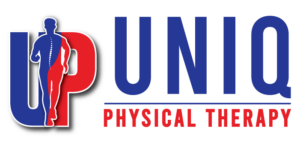Managing Sciatica Pain: Techniques and Therapies for Sciatic Nerve Relief

Managing sciatica pain is essential for individuals experiencing discomfort and limitations associated with this condition. Sciatica, a common nerve-related issue, affects millions of people worldwide. Approximately 40% of adults will experience sciatica pain at some point in their lifetime.
Defining the Sciatic Nerve and Exploring the Causes: Managing Sciatica Pain
Understanding sciatica begins with understanding the sciatic nerve. The sciatic nerve is the largest in the human body, running from the lower back through the buttocks and down each leg. It consists of multiple nerve roots that originate from the lumbar and sacral spine. When the sciatic nerve becomes compressed or irritated, it can lead to sciatica. Contact our team at UNIQ Physical Therapy to learn more
Signs of Sciatica
Radiating Pain
- Sharp or shooting pain that radiates from the lower back or buttock down the back of the thigh, calf, or foot. The pain may vary in intensity and can worsen with movement, sitting, or standing for prolonged periods.
Numbness and Tingling
- Sensations of numbness, tingling, or pins-and-needles in the leg or foot are common signs of sciatica. These symptoms can affect mobility and sensation.
Muscle Weakness
- Weakness or loss of strength in the leg or foot is another common symptom of a compressed nerve. This muscle weakness can make walking, standing, or daily activities difficult.
Burning Sensation
- A burning or electric-like sensation along the path of the sciatic nerve is typical. This sensation may worsen with prolonged sitting or standing and can be debilitating.
Difficulty Sitting or Standing
- Discomfort or pain when sitting for extended periods, standing up from a seated position, or transitioning between sitting and standing. These activities can aggravate sciatica symptoms and limit mobility.
Causes of Sciatica
Herniated Disc
- Disc herniation in the lumbar spine can compress or irritate the adjacent nerve roots, including those that form the sciatic nerve. Disc herniation commonly occurs due to age-related degeneration, trauma, or repetitive stress on the spine.
Spinal Stenosis
- Narrowing in the spinal canal or nerve openings in the lumbar spine leads to compression of the spinal cord or nerve roots. Spinal stenosis can result from age-related changes, bone spurs, or congenital abnormalities.
Degenerative Disc Disease
- Wear and tear of the intervertebral discs in the spine, leading to disc degeneration, bulging, or herniation. Degenerative changes in the discs can cause nerve compression and sciatica symptoms.
Piriformis Syndrome
- Irritation or compression of the sciatic nerve by the piriformis muscle in the buttock region. Piriformis syndrome can occur due to muscle tightness, trauma, or anatomical variations, leading to sciatica symptoms.
How Physical Therapy Can Help You Find Relief With Sciatica Pain
Physical therapy can help in managing sciatica pain and promoting recovery. With a personalized treatment approach tailored to your needs, physical therapy aims to reduce pain, improve mobility, and prevent recurrence of symptoms.
What to Expect with Physical Therapy
Manual Therapy
- Hands-on techniques, including joint mobilization and soft tissue manipulation, reduce pain, improve spinal alignment, and relieve muscle tension. Manual therapy can target specific areas of nerve compression and promote healing.
Therapeutic Exercise
- Customized exercise programs focused on stretching, strengthening, and stabilizing the muscles surrounding the spine and pelvis. These exercises can improve flexibility, alleviate pressure on the sciatic nerve, and enhance overall spinal function.
Postural Correction
- Patients are educated on proper posture and body mechanics to reduce strain on the spine and prevent aggravation of sciatica symptoms. Physical therapists can provide ergonomic recommendations for sitting, standing, lifting, and performing daily activities.
Core Strengthening
- Exercises target the core muscles of the abdomen and lower back to improve spinal stability and support. Strengthening the core muscles can reduce pressure on the lumbar spine and alleviate sciatica symptoms.
Flexibility Training
- Stretching exercises improve flexibility in tight muscles, such as the hamstrings, hip flexors, and piriformis muscles. Enhanced flexibility can alleviate nerve compression and reduce pain associated with sciatica.
Seeking Relief: Call Us to Learn More About Managing Sciatica Pain
If you’re experiencing sciatica symptoms, seeking professional help from a physical therapist is essential for effective management and relief. Physical therapy can help you find relief from sciatica pain, improve mobility, and regain function.
Call our team at UNIQ Physical Therapy in PA today to learn more about managing sciatica pain and discover how physical therapy can help you live pain-free and regain mobility.




